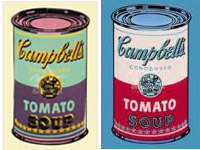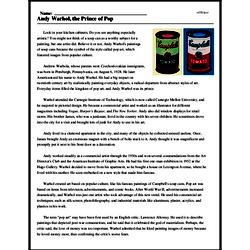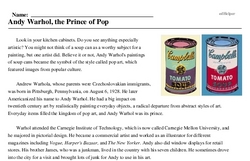Andy Warhol, the Prince of Pop
Andy Warhol
Reading Comprehension for August 6
Look in your kitchen cabinets. Do you see anything especially artistic? You might not think of a soup can as a worthy subject for a painting, but one artist did. Believe it or not, Andy Warhol's paintings of soup cans became the symbol of the style called pop art, which featured images from popular culture.
Andrew Warhola, whose parents were Czechoslovakian immigrants, was born in Pittsburgh, Pennsylvania, on August 6, 1928. He later Americanized his name to Andy Warhol. He had a big impact on twentieth century art by realistically painting everyday objects, a radical departure from abstract styles of art. Everyday items filled the kingdom of pop art, and Andy Warhol was its prince.
Warhol attended the Carnegie Institute of Technology, which is now called Carnegie Mellon University, and he majored in pictorial design. He became a commercial artist and worked as an illustrator for different magazines including Vogue, Harper's Bazaar, and The New Yorker. Andy also did window displays for retail stores. His brother James, who was a junkman, lived in the country with his seven children. He sometimes drove into the city for a visit and brought lots of junk for Andy to use in his art.
Andy lived in a cluttered apartment in the city, and many of the objects he collected seemed useless. Once, James brought Andy an enormous magnet with a bunch of bolts stuck to it. Andy thought it was magnificent and promptly put it next to his front door as a decoration.
Andy worked steadily as a commercial artist through the 1950s and won several commendations from the Art Director's Club and the American Institute of Graphic Arts. He had his first one-man exhibition in 1952 at the Hugo Gallery. Warhol decided to move from his apartment, so he bought a house on Lexington Avenue, where he lived with his mother. He soon embarked on a new style that made him famous.




